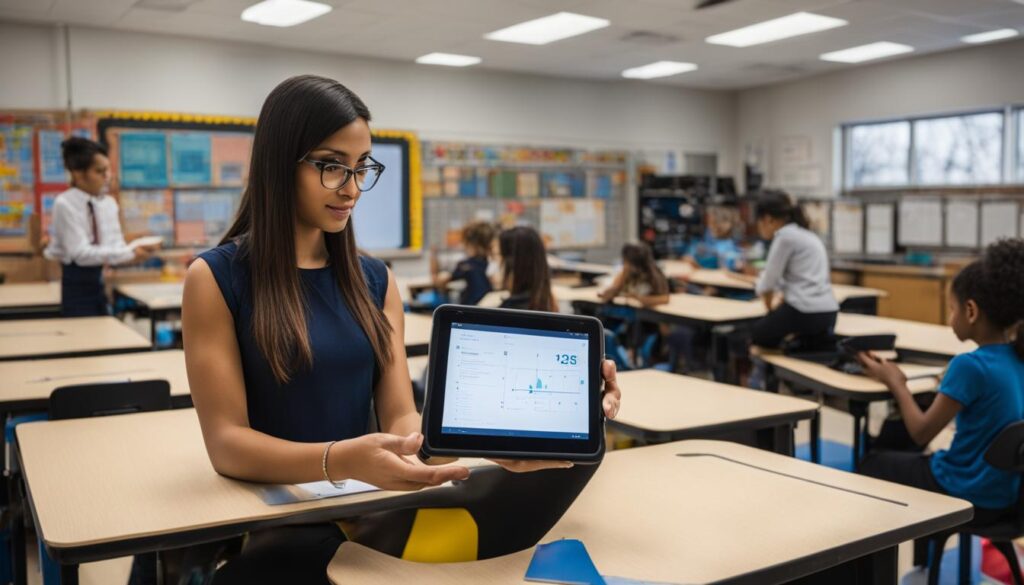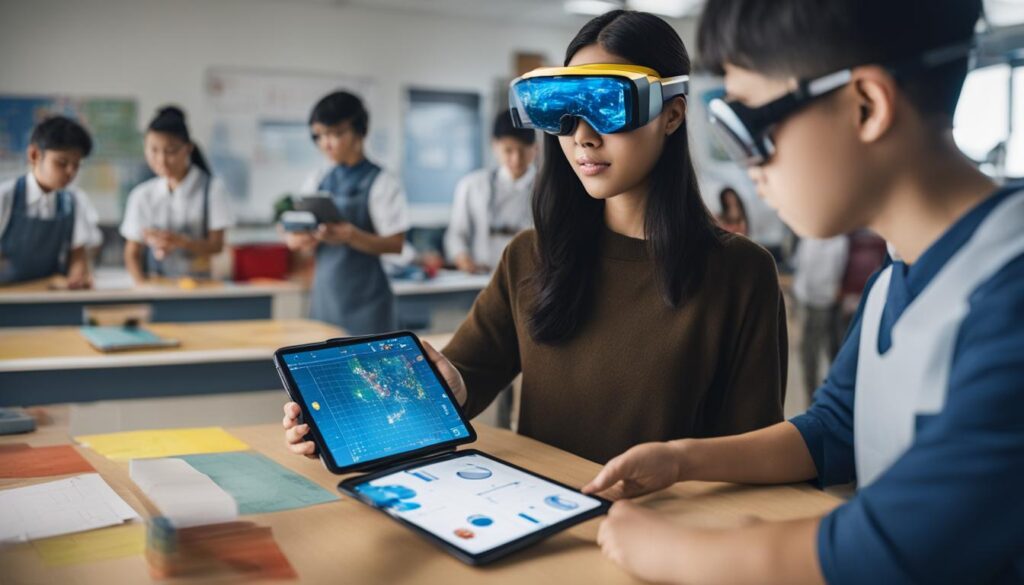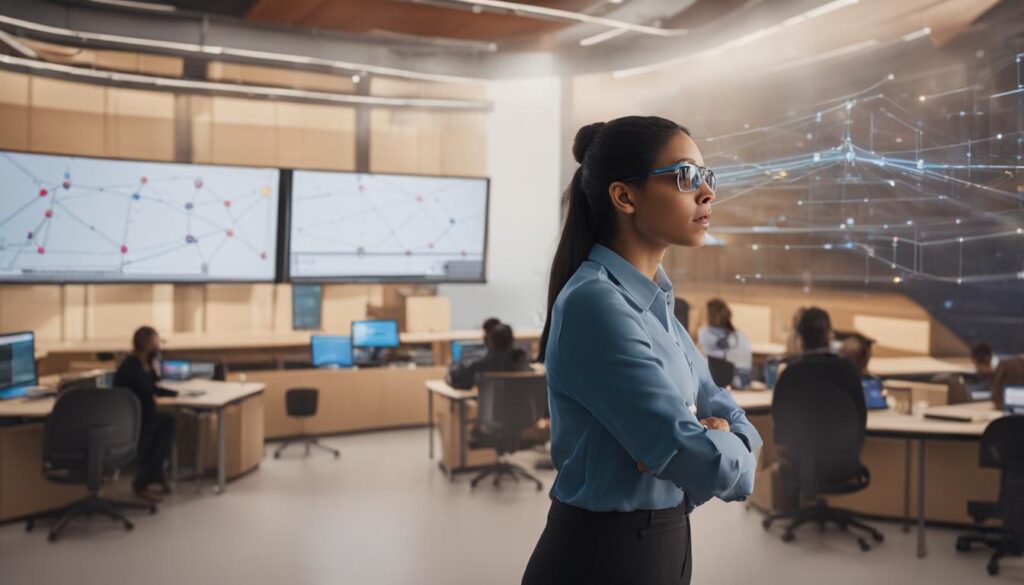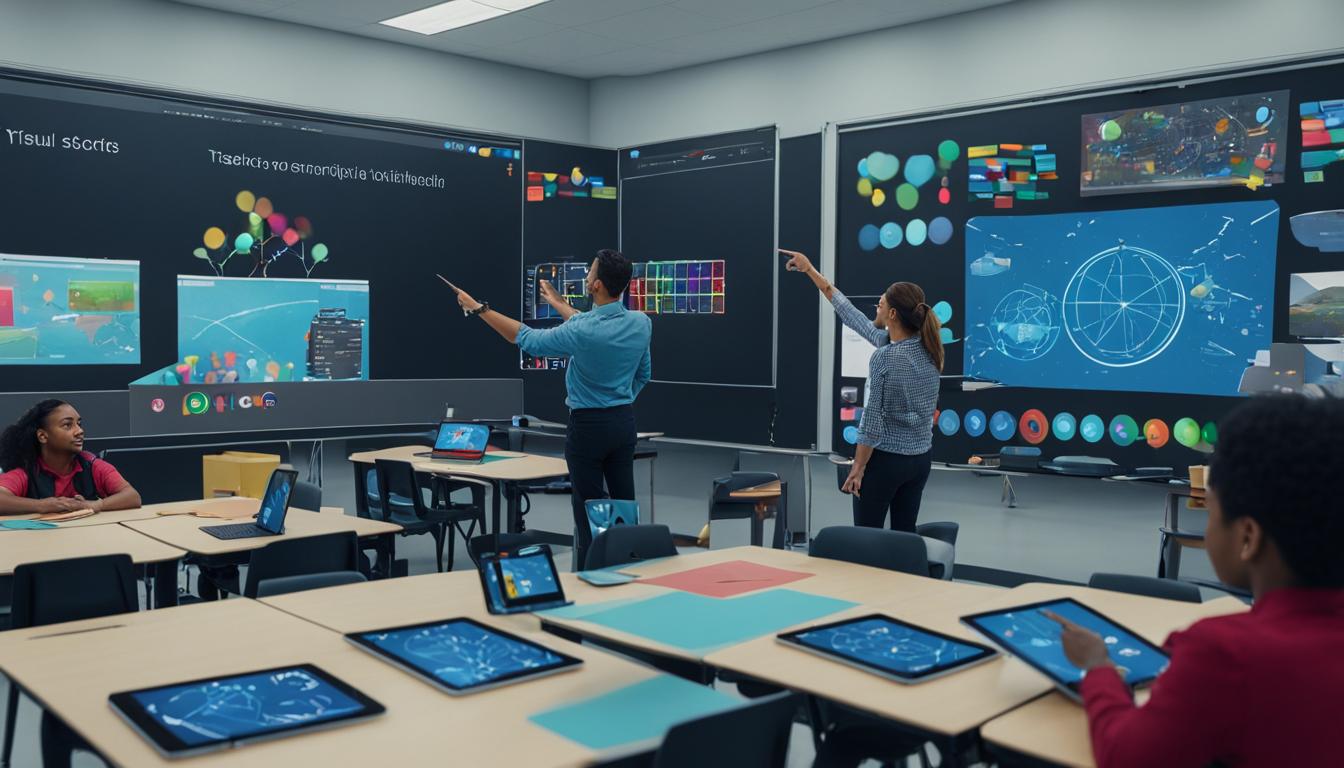Augmented reality (AR) has the potential to revolutionize education by providing teachers with new opportunities to collect valuable data. In this article, we will explore the various types of data that teachers can collect from augmented reality and the benefits it offers in enhancing teaching and learning experiences.
Augmented reality in education allows teachers to gather real-time data on student progress, engagement, and learning outcomes. By using AR applications and tools, teachers can collect data on how students interact with virtual objects, complete tasks, and solve problems. This data can provide insights into student strengths and areas for improvement, enabling teachers to tailor instruction to individual needs and assess the effectiveness of teaching strategies.
Contents
- 1 Collecting Student Data in Augmented Reality
- 2 Enhancing Teaching through Augmented Reality Data
- 3 Augmented Reality in STEM Education
- 4 Teacher Professional Development in Augmented Reality
- 5 Conclusion
- 6 FAQ
- 6.1 What types of data can teachers collect from augmented reality?
- 6.2 What are the benefits of collecting data from augmented reality?
- 6.3 How can augmented reality data collection enhance teaching practices?
- 6.4 How can teachers collect student data in augmented reality?
- 6.5 How can augmented reality be used in STEM education?
- 6.6 What training do teachers need to effectively utilize augmented reality in the classroom?
- 6.7 What challenges and considerations should teachers be aware of when collecting data in augmented reality?
- 7 Source Links
Key Takeaways:
- Augmented reality provides teachers with unique opportunities to collect data on student performance and engagement.
- AR data can be used to identify areas of strength and areas for improvement, tailor instruction, and assess teaching strategies.
- Collecting data in AR can enhance teaching practices by providing valuable insights into student learning styles and preferences.
- AR can be particularly beneficial in STEM education, allowing students to explore complex concepts and conduct virtual experiments.
- Teacher professional development programs focused on augmented reality can support effective integration into the classroom.
Collecting Student Data in Augmented Reality
Augmented reality (AR) provides teachers with unique opportunities to collect valuable data on student performance and engagement. By leveraging data in augmented reality, teachers can gain valuable insights into student learning, tailor instruction, and assess the effectiveness of teaching strategies.
AR applications and tools enable teachers to gather real-time data on how students interact with virtual objects, complete tasks, and solve problems. This data can be used to identify areas of strength and areas for improvement, facilitating personalized instruction that addresses individual student needs.
One way teachers can collect useful data from augmented reality is by tracking student progress and engagement. AR technologies allow for the collection of objective data such as completion times, accuracy rates, and task completion rates. This data can be analyzed to identify trends and patterns, enabling teachers to identify struggling students, address misconceptions, and provide timely interventions.
Beyond performance metrics, AR can provide teachers with additional valuable data points, such as student preferences and learning styles. By observing how students interact with AR experiences and analyzing the choices they make, teachers can gain insights into individual learning preferences and tailor instruction accordingly.
By collecting student data in augmented reality, teachers can unlock valuable insights into student performance, engagement, and learning preferences. This data can be leveraged to enhance teaching strategies, personalize instruction, and improve overall learning outcomes.
In addition, augmented reality can provide teachers with a wealth of data on collaboration and problem-solving skills. Through AR experiences that promote teamwork and critical thinking, teachers can observe how students work together, communicate ideas, and approach challenges. This data can inform instructional decisions and enable teachers to design activities that foster collaboration and the development of twenty-first-century skills.
By embracing augmented reality as a tool for data collection, teachers can harness the power of technology to enhance their teaching practices and improve student outcomes. With the ability to collect and leverage data in augmented reality, teachers have a unique opportunity to gain deep insights into student learning and make data-informed decisions to support their students’ growth.
Example Table: Student Data Collected in Augmented Reality
| Data Category | Examples |
|---|---|
| Performance Metrics | Completion times, accuracy rates, task completion rates |
| Learning Preferences | Interactions with AR objects, choices within AR experiences |
| Collaboration | Observations of teamwork, communication, and problem-solving |
By leveraging data from augmented reality, teachers can gain valuable insights into student learning, personalize instruction, and create engaging learning experiences. Augmented reality has the potential to revolutionize data collection in education, providing teachers with a powerful tool to support student growth and improve learning outcomes.
Enhancing Teaching through Augmented Reality Data
Augmented reality data collection can revolutionize teaching practices, empowering educators with invaluable insights into student learning and engagement. By leveraging the data collected through augmented reality (AR) applications, teachers gain a deeper understanding of individual student needs, preferences, and misconceptions, enabling them to tailor instruction accordingly.
AR data analysis enables teachers to make informed instructional decisions by selecting appropriate teaching strategies and resources to address specific learning styles and student challenges. This personalized approach to instruction fosters a supportive and inclusive learning environment, where students can thrive and reach their full potential.
Furthermore, AR data collection enhances teachers’ ability to monitor student progress and track skill development over time. By analyzing the data collected through AR experiences, educators can identify areas where students are excelling and areas that may require additional support. This allows teachers to intervene promptly and provide targeted interventions, leading to improved learning outcomes.
Benefits of Augmented Reality Data Collection for Teachers
By utilizing AR data collection, teachers can:
- Identify individual student learning styles and preferences
- Address misconceptions and provide targeted support
- Personalize instruction to meet the needs of each student
- Monitor student progress and make data-driven decisions
- Track skill development and assess learning outcomes
Augmented reality data collection holds immense potential for transforming teaching practices. It empowers teachers to be adaptive, responsive, and proactive in meeting the diverse needs of students, ultimately creating more engaging and effective learning experiences.

“AR data collection enables teachers to gain a deeper understanding of student learning styles and preferences. This information allows for personalized instruction and targeted support, leading to improved learning outcomes.”
Augmented Reality in STEM Education
Augmented reality (AR) has proven to be highly beneficial in the field of STEM education. By integrating AR into STEM lessons, teachers can enhance student engagement, facilitate deeper understanding of complex concepts, and collect valuable data on student performance and participation. The immersive and interactive nature of AR allows students to explore scientific phenomena, conduct virtual experiments, and visualize abstract ideas in a realistic and captivating way.
One of the key advantages of using AR in STEM education is the ability to collect data on students’ interactions with virtual objects. This data can provide valuable insights into students’ understanding of scientific principles and their ability to apply them in practical scenarios. For example, teachers can track how students manipulate virtual molecules in a chemistry lesson or observe how they navigate a virtual circuit in an electronics activity.
AR also enables teachers to gather data on students’ problem-solving strategies and collaboration skills. Through carefully designed AR activities, students can collaborate on solving real-world challenges and teachers can monitor their teamwork, communication, and critical thinking abilities. This data can inform instructional decisions and help educators identify areas where additional support may be needed.
Below is an example of how data can be collected through an AR activity:

An Example of AR Data Collection
| Student | Task Completion Time (in minutes) | Level of Engagement | Problem-Solving Approach |
|---|---|---|---|
| Emily | 10 | High | Trial and Error |
| James | 8 | Medium | Sequential Steps |
| Sarah | 12 | Low | Collaborative Brainstorming |
By analyzing this data, teachers can gain valuable insights into students’ individual strengths, challenges, and learning preferences. This knowledge can then be used to tailor instruction to meet the specific needs of each student, providing personalized learning experiences that enhance both academic achievement and student engagement.
Integrating augmented reality into STEM education not only enhances students’ learning experiences but also empowers teachers with valuable data for informed decision-making.
Teacher Professional Development in Augmented Reality
To effectively utilize augmented reality in the classroom, teachers require professional development and training. Teacher professional development programs focused on augmented reality can help teachers become familiar with the technology, understand its potential benefits, and develop the necessary skills to integrate it into their teaching practices.
These programs can provide teachers with hands-on experiences in using AR applications, guidance on designing AR-enhanced lessons, and strategies for data collection and analysis. By equipping teachers with the knowledge and skills to effectively utilize augmented reality, professional development programs can empower teachers to leverage AR to enhance teaching and improve student learning outcomes.
“Professional development programs focused on augmented reality can empower teachers to leverage AR to enhance teaching and improve student learning outcomes.”
Benefits of Professional Development in Augmented Reality
1. Increased Familiarity: Teacher training programs expose educators to the various AR technologies available, allowing them to explore the different applications and tools that can be used in the classroom.
2. Understanding Potential: Teachers learn about the potential benefits of augmented reality in education, such as increased student engagement, enhanced visualization of complex concepts, and improved comprehension and retention of information.
3. Integration Skills: Professional development programs provide teachers with the necessary skills to integrate AR into their teaching practices, including designing AR-enhanced lessons, selecting appropriate AR applications, and effectively managing AR experiences in the classroom.
4. Data Collection and Analysis: Teachers gain insights into how to collect and analyze data from augmented reality experiences, enabling them to monitor student progress, assess learning outcomes, and make informed instructional decisions.
Example Professional Development Program
An example of a professional development program for augmented reality in education is the AR Academy for Educators. This program offers teachers comprehensive training on the use of augmented reality in the classroom. The program includes hands-on workshops, online modules, and ongoing support to help teachers integrate AR technology into their teaching practices.
| Key Features of AR Academy for Educators | Benefits for Teachers |
|---|---|
| Hands-on Workshops | Opportunity to practice using AR applications and tools in a guided environment |
| Online Modules | Flexible learning options, allowing teachers to access content at their own pace |
| Ongoing Support | Access to a community of educators and experts for continued learning and collaboration |
By participating in programs like the AR Academy for Educators, teachers can gain the knowledge, skills, and confidence to effectively utilize augmented reality in the classroom, ultimately improving the learning experiences and outcomes of their students.

Conclusion
Augmented reality (AR) holds immense potential for transforming data collection in education and empowering teachers with valuable insights into student learning and engagement. By utilizing AR applications and tools, teachers can gather data on student performance, monitor progress, and customize instruction to meet the unique needs of each student. However, to effectively harness the power of AR, teachers must receive adequate training, consider ethical and privacy implications, and align their practices with curriculum standards.
AR data collection offers numerous benefits for teachers. It enables them to gather real-time data on student interactions with virtual objects, problem-solving abilities, and collaborative skills. This valuable information can inform instructional decisions, drive personalized learning experiences, and evaluate the effectiveness of teaching strategies. Moreover, AR has found particular relevance in STEM education, allowing students to explore complex concepts, conduct virtual experiments, and develop crucial twenty-first century skills.
While embracing AR data collection, teachers must also address challenges such as the availability and accessibility of AR technology, data privacy concerns, and the need for ongoing support and resources. By carefully considering these factors and receiving proper support, teachers can maximize the benefits of AR in the classroom and enhance student outcomes. Augmented reality has the potential to revolutionize education by providing teachers with a wealth of data and insights, ultimately leading to more effective teaching practices and improved student learning in the digital age.
FAQ
What types of data can teachers collect from augmented reality?
Teachers can collect data on student performance, engagement, and learning outcomes through augmented reality applications and tools.
What are the benefits of collecting data from augmented reality?
Collecting data from augmented reality allows teachers to identify areas for improvement, tailor instruction to individual student needs, and assess the effectiveness of teaching strategies.
How can augmented reality data collection enhance teaching practices?
By analyzing the data gathered through augmented reality, teachers can gain insights into student learning styles, preferences, and misconceptions, which can inform instructional decisions and support individualized instruction.
How can teachers collect student data in augmented reality?
Teachers can collect student data in real-time by using augmented reality applications and tools to track how students interact with virtual objects, complete tasks, and solve problems.
How can augmented reality be used in STEM education?
Augmented reality can be integrated into STEM lessons to provide immersive and interactive experiences for students, allowing them to explore complex concepts, conduct virtual experiments, and visualize abstract ideas.
What training do teachers need to effectively utilize augmented reality in the classroom?
Teachers require professional development and training programs focused on augmented reality to become familiar with the technology, understand its benefits, and develop the necessary skills to integrate it into their teaching practices.
What challenges and considerations should teachers be aware of when collecting data in augmented reality?
Teachers should consider the availability and accessibility of AR technology, the need for training and professional development, data privacy and security, ethical concerns, alignment with curriculum standards, and the need for ongoing support and resources.




